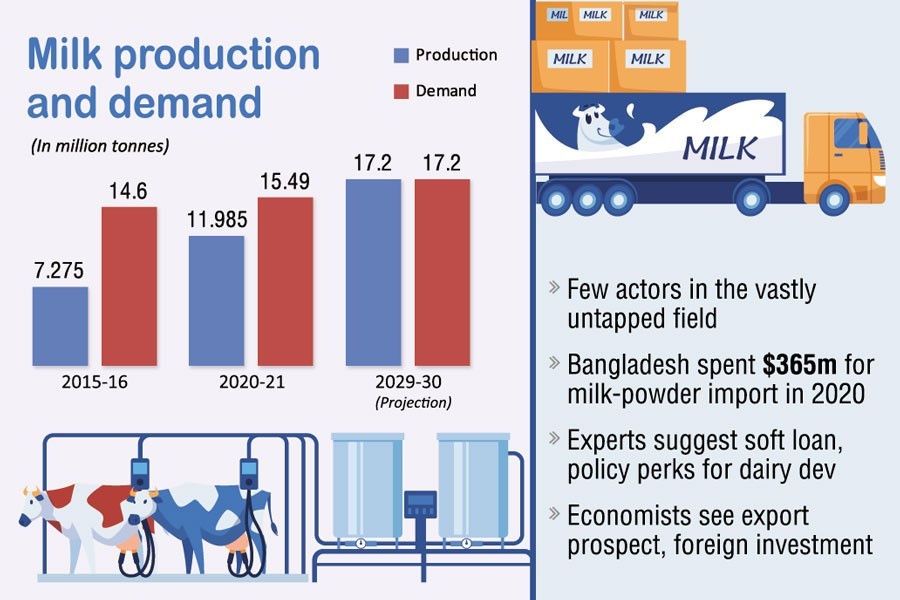True potential of Bangladesh's dairy industry, which now processes only nine per cent of the country's total fresh milk, remains largely unexplored for what appears to be import bias.
There are immense opportunities for investment from home and abroad in the milk-processing sector as only a handful of actors are in the trade, experts told the FE.
"When an item like fresh milk is processed in formal channel, it creates multiple benefits for the industry and the economy," says economist Dr Khandaker Golam Moazzem of the Centre for Policy Dialogue (CPD).
"There will be standardisation, better quality control and wide scope of investment when it comes to formal channel," he observes about the way forward for flourishing the sector.
Explaining the opportunities the sector holds out, he mentioned that many people do not buy non-pasteurised fresh milk from individual vendors for fear of substandard quality or other hazards. "But if they find fresh milk available in pasteurised form, they will feel encouraged to buy it."
He also opined that huge jobs would be created through industrial expansion of the formal chain by industrialisation of milk processing.
"All the people involved with the supply chain, including farmers, distributors, transporters, processors and many others, will be benefitted."
It would also reduce dependency on import and create opportunities for export also. And these prospects would attract foreign investment in the sector, Dr Moazzzem noted, highlighting the opportunities of the dairy industry.
Due to supply constraints and lack of optimal quality enhancement the country has to import milk powder. It spent US$ 365 million for milk-powder import in 2020, in a cumulative increase from $250 million in 2015.
Many companies in the processing industry, like sweetmeat and ice-cream producers, use imported bulk milk powder for its low cost.
According to a survey, the size of Bangladesh's milk market is $2,465 million (2.47 billion), and it is expected to rise over 5.0 per cent in annualised growth in the coming years.
Unfortunately, the dairy market is dominated by unprocessed, raw milk, and the processed segment is dominated by imported powder milk.
Presently, three milk-processing companies hold 92-per cent share of the local dairy-product market. The rest goes to other companies, numbering not more than 12, according to industry-insiders.
The state-owned Milk Vita is the market leader -- having over 45 per cent share--followed by Aarong, Pran and Akij.
Talking to the FE, Managing Director of Milk Vita Amar Chan Banik said that they had taken several expansion programmes.
"We have taken projects worth over Tk 5.0 billion in Faridpur and Patia for expansion of milk-procurement areas. We will give soft loan to the farmers for milk production.
"Very soon a milk-processing factory will be commissioned in Baghabari. The factory will produce milk powder and other dairy products."
Milk Vita posted around Tk 5.0 billion worth of revenue last year, up by 30 per cent from previous year's.
According to Mr Banik, product diversification is one of the reasons that resulted in the revenue rise.
"Now we have 22 varieties of dairy products," he informed.
Pran, Aarong and Akij are also expanding their operations.
On the other hand, the production of fresh milk saw a 3.6-per cent growth over the decade. But, its supply-demand gap is still wide, as demand grew at a rate of 4.0 per cent in the same period.
In the 2020-21 fiscal year, the production of fresh milk in the country was 11.9 million tonnes and the demand was 15.4 million tonnes, as per data provided by the Department of Livestock.
The Department of Livestock has a projection to be self-sufficient in milk production by 2030 with an aggregate output of 17.22 million tonnes.
The Integrated Dairy Research Network (IDRN) of the Bangladesh Agriculture University, however, differs with the projection. Its estimation shows that in 2030 the country can meet 80 per cent of the local demand.
Daily consumption of dairy products in Bangladesh remains relatively low -- 47 millilitres per day per person--whereas the World Health Organisation's recommendation is 250 millilitres per day per person.
It would also make the investors encouraged, experts said, prescribing soft loan and other policy supports for this cent-percent value-added sector.
Milk yields here are among the lowest in the world, with limited uptake of modern management and technology in dairy farming. The average yield of a local-variety cow is 2-2.5 litres per day compared to the 14-15 litres of high-yielding varieties.
The experts suggest introduction of high-yield cows in the dairy sector to increase production and reduce cost. High technology is also used nowadays for husbandry and milking
The dairy sector as a whole suffered setbacks during the Covid pandemic. According to Dr Mohammad Mohi Uddin, Network Coordinator of the IDRN, the milk sector lost Tk 123.20 billion due to disruption to supply chain during the pandemic.


